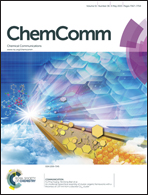An artificial receptor synthesized by surface-confined imprinting for the recognition of acetylation on histone H4 K16†
Abstract
A novel artificial receptor has been synthesized using surface-confined imprinting for the recognition of lysine acetylation in histone H4. The material has high recognition fidelity and epitope affinity. It was demonstrated that acetylated Lys plays a role in binding site creation and peptide imprinting can be performed in phosphate buffer.


 Please wait while we load your content...
Please wait while we load your content...